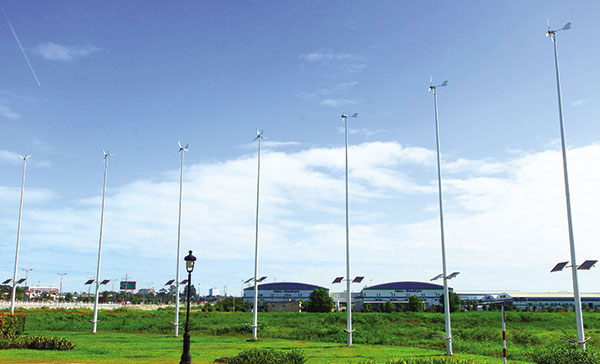GGGI unites GDP and green growth
 What opportunities will this Country Planning Framework (CPF) give to investors in Vietnam, in the reform of the country’s energy sector?
What opportunities will this Country Planning Framework (CPF) give to investors in Vietnam, in the reform of the country’s energy sector?
GGGI will look to work with the private sector throughout the CPF in its role as a key stakeholder in delivering green growth. Specifically, GGGI will develop bankable projects for key green growth infrastructure and will seek finance for Vietnam’s government from a multitude of sources, such as multilateral development banks, bilateral sources, and private sector financial institutions.
One of the main focuses in the CPF is to improve the geothermal, waste-to-energy, and solar sub-sectors in Vietnam, and work on strategic policy advice such as the necessary feed-in tariffs (FiT). Why is this important to Vietnam and foreign investors?
FiTs are important to Vietnamese and foreign investors because they are effective as incentives for the development of renewable energy. A recent GGGI report, which looked at China, India, the Philippines, Indonesia, Thailand, and Vietnam, showed that though FiTs need to be set high to begin with, but they can quickly be reduced.
This can be achieved once investors see there is a solid regulatory environment for them to recoup their investment. New markets are always risky, but once established this risk decreases, potentially very quickly. For example, in India the initial FiT for solar was around $0.16 per kilowatt hour (kWh) in 2010 but this has already decreased to around $0.075/kWh today.

GGGI has a strategy for Vietnam becoming more green while still growing its GDP
Photo: Le Toan
International organisations have repeatedly warned that Vietnam’s emissions will continue surging due to its massive reliance on coal. However, it would be quite expensive for Vietnam to develop renewable energy sources. What is your view on this?
I feel that Vietnam can implement renewable energy and see an improvement in its overall finances.
Firstly, the funds for renewable energy can be provided by the private sector. This means Vietnam’s government does not have to take on any more public debt to build the necessary infrastructure.
Secondly, the true cost of coal-fired power generation hasn’t been factored into the price for the electricity generated, in terms of long-term environmental and health impacts.
Thirdly, electricity prices in Vietnam are quite low, and this presents a challenge to tackling climate change in two ways; by making renewables seem expensive and by not encouraging the industry to implement energy efficiency measures – these are “win-wins” as they will save the firm money overall, increase economic efficiency, and reduce emissions.
We have heard at a recent EuroCham-hosted event in Hanoi that EuroCham members are happy to pay for higher electricity prices and this would stimulate energy efficiency measures.
A recent report by EuroCham highlighted the key reasons their members established operations in Vietnam, namely the highly educated local workforce, excellent trade logistics, and access to raw materials – not for the low electricity prices. They fully expect electricity prices to rise. A roadmap outlining how much and when prices will increase will allow all power users in Vietnam to plan the implementation of energy efficiency measures.
What are the biggest challenges facing Vietnam’s efforts to pursue green growth?
There are two major challenges. Firstly, in terms of access to finance, between 2016-2020, the Ministry of Planning and Investment estimates that achieving national green growth objectives will require an additional $30-40 billion, so how can all development partners work with the government to access the necessary finance to transition to a green growth pathway?
The good news is that there are many sources of finance out there and Vietnam has been successful in accessing them. Multilateral development banks such as the Asian Development Bank (ADB) have been helpful in providing this finance.
Also important will be the private sector, which is very promising in terms of the scale of financial resources, for example in building a renewable energy infrastructure.
The second challenge is translating overarching policies into implementation on the ground. The government has had a number of successes in setting policies and strategies, such as the green growth strategy and action plan, but there is still work that needs to be done in the policy environment supporting implementation on the ground – for example to mainstream green growth throughout all relevant policies.
*The Global Green Growth Institute (GGGI) is a treaty-based international organisation headquartered in Seoul, South Korea. GGGI provides research and stakeholder engagement for green growth plans, aiming to replace the more typical paradigm based on industrial development.
What the stars mean:
★ Poor ★ ★ Promising ★★★ Good ★★★★ Very good ★★★★★ Exceptional
Latest News
More News
- UOB sees Vietnam growth easing in fourth quarter (December 22, 2025 | 17:39)
- Government moves to establish International Financial Centre (December 21, 2025 | 21:00)
- Vietnam's IFC to target global investment flows (December 21, 2025 | 18:00)
- Ha Tinh breaks ground on major Vingroup industrial and energy projects (December 19, 2025 | 18:24)
- EVN launches major power infrastructure projects nationwide (December 19, 2025 | 18:17)
- VAL inaugurates second production line to meet domestic animal feed demand (December 19, 2025 | 16:37)
- Sun Group pioneers urban tram system in Phu Quoc (December 19, 2025 | 15:00)
- Top 10 notable events of Vietnam’s industry and trade sector in 2025 (December 19, 2025 | 14:00)
- Seven major projects launched to drive Hanoi’s next growth phase (December 19, 2025 | 14:00)
- Rare, beautiful, sustainable: the mark of iconic real estate (December 19, 2025 | 08:00)

















 Mobile Version
Mobile Version